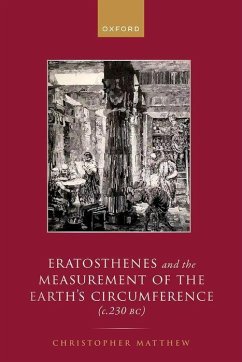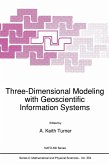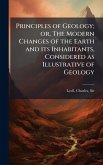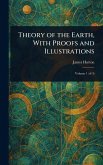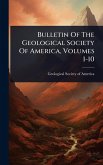Christopher A Matthew
Eratosthenes and the Measurement of the Earth's Circumference (C.230 Bc)
Christopher A Matthew
Eratosthenes and the Measurement of the Earth's Circumference (C.230 Bc)
- Gebundenes Buch
- Merkliste
- Auf die Merkliste
- Bewerten Bewerten
- Teilen
- Produkt teilen
- Produkterinnerung
- Produkterinnerung
Eratosthenes and the Measurement of the Earth's Circumference (c.230 BC) is an innovative and thought-provoking examination of one of the pivotal moments in the history of science. This text analyses a debate that has been going on for more than 2,300 years over the accuracy of Eratosthenes' experiment and calculations.
Andere Kunden interessierten sich auch für
![Observations on the Temple of Serapis At Pozzuoli Near Naples; With an Attempt to Explain the Causes of the Frequent Elevation and Depression of Large Portions of the Earth's Surface in Remote Periods, and to Prove That Those Causes Continue in Action At Observations on the Temple of Serapis At Pozzuoli Near Naples; With an Attempt to Explain the Causes of the Frequent Elevation and Depression of Large Portions of the Earth's Surface in Remote Periods, and to Prove That Those Causes Continue in Action At]() Charles BabbageObservations on the Temple of Serapis At Pozzuoli Near Naples; With an Attempt to Explain the Causes of the Frequent Elevation and Depression of Large Portions of the Earth's Surface in Remote Periods, and to Prove That Those Causes Continue in Action At28,99 €
Charles BabbageObservations on the Temple of Serapis At Pozzuoli Near Naples; With an Attempt to Explain the Causes of the Frequent Elevation and Depression of Large Portions of the Earth's Surface in Remote Periods, and to Prove That Those Causes Continue in Action At28,99 €![Three-Dimensional Modeling with Geoscientific Information Systems Three-Dimensional Modeling with Geoscientific Information Systems]() A.K. Turner (Hrsg.)Three-Dimensional Modeling with Geoscientific Information Systems226,99 €
A.K. Turner (Hrsg.)Three-Dimensional Modeling with Geoscientific Information Systems226,99 €![The Hidden History of Earth Expansion The Hidden History of Earth Expansion]() The Hidden History of Earth Expansion35,99 €
The Hidden History of Earth Expansion35,99 €![The Wonders of Geology; or A Familiar Exposition of Geological Phenomena The Wonders of Geology; or A Familiar Exposition of Geological Phenomena]() Gideon Algernon MantellThe Wonders of Geology; or A Familiar Exposition of Geological Phenomena37,99 €
Gideon Algernon MantellThe Wonders of Geology; or A Familiar Exposition of Geological Phenomena37,99 €![Principles of Geology; or, The Modern Changes of the Earth and its Inhabitants, Considered as Illustrative of Geology Principles of Geology; or, The Modern Changes of the Earth and its Inhabitants, Considered as Illustrative of Geology]() Charles LyellPrinciples of Geology; or, The Modern Changes of the Earth and its Inhabitants, Considered as Illustrative of Geology40,99 €
Charles LyellPrinciples of Geology; or, The Modern Changes of the Earth and its Inhabitants, Considered as Illustrative of Geology40,99 €![Theory of the Earth, With Proofs and Illustrations Theory of the Earth, With Proofs and Illustrations]() James HuttonTheory of the Earth, With Proofs and Illustrations30,99 €
James HuttonTheory of the Earth, With Proofs and Illustrations30,99 €![Bulletin Of The Geological Society Of America, Volumes 1-10 Bulletin Of The Geological Society Of America, Volumes 1-10]() Bulletin Of The Geological Society Of America, Volumes 1-1031,99 €
Bulletin Of The Geological Society Of America, Volumes 1-1031,99 €-
-
-
Eratosthenes and the Measurement of the Earth's Circumference (c.230 BC) is an innovative and thought-provoking examination of one of the pivotal moments in the history of science. This text analyses a debate that has been going on for more than 2,300 years over the accuracy of Eratosthenes' experiment and calculations.
Produktdetails
- Produktdetails
- Verlag: Oxford University Press
- Seitenzahl: 352
- Erscheinungstermin: 31. Oktober 2023
- Englisch
- Abmessung: 231mm x 168mm x 33mm
- Gewicht: 748g
- ISBN-13: 9780198874294
- ISBN-10: 0198874294
- Artikelnr.: 69076849
- Herstellerkennzeichnung
- Libri GmbH
- Europaallee 1
- 36244 Bad Hersfeld
- gpsr@libri.de
- Verlag: Oxford University Press
- Seitenzahl: 352
- Erscheinungstermin: 31. Oktober 2023
- Englisch
- Abmessung: 231mm x 168mm x 33mm
- Gewicht: 748g
- ISBN-13: 9780198874294
- ISBN-10: 0198874294
- Artikelnr.: 69076849
- Herstellerkennzeichnung
- Libri GmbH
- Europaallee 1
- 36244 Bad Hersfeld
- gpsr@libri.de
Christopher A. Matthew is a lecturer in ancient history at the Australian Catholic University in Sydney, also teaching courses on the Greek City States, the Roman Republic, Pompeii, Ancient Greek Drama and the Ancient Near East. He is leading researcher in the study of ancient warfare and his research has been recognised both nationally and internationally.
Acknowledgements
Contents
Abbreviations
Illustrations
Tables
Preface
Section 1: Historical Background
1.1: The Sources
1.2: Eratosthenes, the man
1.3: Alexandria
1.4: Greek astronomical thought before the time of Eratosthenes
Section 2: The Experiment
2.1: Eratosthenes' experiment
2.2: Eratosthenes' sundial
2.3: Time and the solstices in Ancient Eygpt and Greece
2.4: Ancient Eygptian and Greek sundials to the time of Eratosthenes
2.5: A replica of Eratosthenes' skaphe
Section 3: The Analysis
3.1: The angle
3.2: Errors in Eratosthenes' methodology
3.2.1 The effect of Syene and Alexandria not sitting on the same Longtitudinal Meridian
3.2.2 The effect of Syene not sitting on the Tropic of Cancer
3.2.3 The effect of the oblateness of the Earth
3.2.4 The effect of non-parallel rays of light from the sun
3.2.5 The effect of the components of the shadow
3.2.6 The effect of the Earth's rotation
3.2.7 The effect of atmospheric refraction
3.2.8 The effect of operational and Instrumental error
3.2.9 The total effect of the errors
Section 4: The Stade
4.1: The size of the stade
4.2: Previous estimates of the size of Eratosthenes' stade
Section 5: The Re-examination
5.1: Eratosthenes and the 180m stade
5.1.1 Caspian Gates to Hecatompylos
5.1.2 Hecatompylos to Alexandria Aerion
5.1.3 Alexandria Aerion to Prophthasia
5.1.4 Prophthasia to Arachoti Polis
5.1.5 Arachoti Polis to Hortospana
5.1.6 Alexandria Aerion to Bactra-Zariaspa
5.1.7 Alexandria to Syene
5.2: The 180m Stade and the circumference of the Earth
Section 6: The Circumference
6.1: The Accuracy of Eratosthenes' Circumference
6.2: Eratosthenes' legacy
References
Ancient and medieval sources
Modern sources
Electronic sources
Contents
Abbreviations
Illustrations
Tables
Preface
Section 1: Historical Background
1.1: The Sources
1.2: Eratosthenes, the man
1.3: Alexandria
1.4: Greek astronomical thought before the time of Eratosthenes
Section 2: The Experiment
2.1: Eratosthenes' experiment
2.2: Eratosthenes' sundial
2.3: Time and the solstices in Ancient Eygpt and Greece
2.4: Ancient Eygptian and Greek sundials to the time of Eratosthenes
2.5: A replica of Eratosthenes' skaphe
Section 3: The Analysis
3.1: The angle
3.2: Errors in Eratosthenes' methodology
3.2.1 The effect of Syene and Alexandria not sitting on the same Longtitudinal Meridian
3.2.2 The effect of Syene not sitting on the Tropic of Cancer
3.2.3 The effect of the oblateness of the Earth
3.2.4 The effect of non-parallel rays of light from the sun
3.2.5 The effect of the components of the shadow
3.2.6 The effect of the Earth's rotation
3.2.7 The effect of atmospheric refraction
3.2.8 The effect of operational and Instrumental error
3.2.9 The total effect of the errors
Section 4: The Stade
4.1: The size of the stade
4.2: Previous estimates of the size of Eratosthenes' stade
Section 5: The Re-examination
5.1: Eratosthenes and the 180m stade
5.1.1 Caspian Gates to Hecatompylos
5.1.2 Hecatompylos to Alexandria Aerion
5.1.3 Alexandria Aerion to Prophthasia
5.1.4 Prophthasia to Arachoti Polis
5.1.5 Arachoti Polis to Hortospana
5.1.6 Alexandria Aerion to Bactra-Zariaspa
5.1.7 Alexandria to Syene
5.2: The 180m Stade and the circumference of the Earth
Section 6: The Circumference
6.1: The Accuracy of Eratosthenes' Circumference
6.2: Eratosthenes' legacy
References
Ancient and medieval sources
Modern sources
Electronic sources
Acknowledgements
Contents
Abbreviations
Illustrations
Tables
Preface
Section 1: Historical Background
1.1: The Sources
1.2: Eratosthenes, the man
1.3: Alexandria
1.4: Greek astronomical thought before the time of Eratosthenes
Section 2: The Experiment
2.1: Eratosthenes' experiment
2.2: Eratosthenes' sundial
2.3: Time and the solstices in Ancient Eygpt and Greece
2.4: Ancient Eygptian and Greek sundials to the time of Eratosthenes
2.5: A replica of Eratosthenes' skaphe
Section 3: The Analysis
3.1: The angle
3.2: Errors in Eratosthenes' methodology
3.2.1 The effect of Syene and Alexandria not sitting on the same Longtitudinal Meridian
3.2.2 The effect of Syene not sitting on the Tropic of Cancer
3.2.3 The effect of the oblateness of the Earth
3.2.4 The effect of non-parallel rays of light from the sun
3.2.5 The effect of the components of the shadow
3.2.6 The effect of the Earth's rotation
3.2.7 The effect of atmospheric refraction
3.2.8 The effect of operational and Instrumental error
3.2.9 The total effect of the errors
Section 4: The Stade
4.1: The size of the stade
4.2: Previous estimates of the size of Eratosthenes' stade
Section 5: The Re-examination
5.1: Eratosthenes and the 180m stade
5.1.1 Caspian Gates to Hecatompylos
5.1.2 Hecatompylos to Alexandria Aerion
5.1.3 Alexandria Aerion to Prophthasia
5.1.4 Prophthasia to Arachoti Polis
5.1.5 Arachoti Polis to Hortospana
5.1.6 Alexandria Aerion to Bactra-Zariaspa
5.1.7 Alexandria to Syene
5.2: The 180m Stade and the circumference of the Earth
Section 6: The Circumference
6.1: The Accuracy of Eratosthenes' Circumference
6.2: Eratosthenes' legacy
References
Ancient and medieval sources
Modern sources
Electronic sources
Contents
Abbreviations
Illustrations
Tables
Preface
Section 1: Historical Background
1.1: The Sources
1.2: Eratosthenes, the man
1.3: Alexandria
1.4: Greek astronomical thought before the time of Eratosthenes
Section 2: The Experiment
2.1: Eratosthenes' experiment
2.2: Eratosthenes' sundial
2.3: Time and the solstices in Ancient Eygpt and Greece
2.4: Ancient Eygptian and Greek sundials to the time of Eratosthenes
2.5: A replica of Eratosthenes' skaphe
Section 3: The Analysis
3.1: The angle
3.2: Errors in Eratosthenes' methodology
3.2.1 The effect of Syene and Alexandria not sitting on the same Longtitudinal Meridian
3.2.2 The effect of Syene not sitting on the Tropic of Cancer
3.2.3 The effect of the oblateness of the Earth
3.2.4 The effect of non-parallel rays of light from the sun
3.2.5 The effect of the components of the shadow
3.2.6 The effect of the Earth's rotation
3.2.7 The effect of atmospheric refraction
3.2.8 The effect of operational and Instrumental error
3.2.9 The total effect of the errors
Section 4: The Stade
4.1: The size of the stade
4.2: Previous estimates of the size of Eratosthenes' stade
Section 5: The Re-examination
5.1: Eratosthenes and the 180m stade
5.1.1 Caspian Gates to Hecatompylos
5.1.2 Hecatompylos to Alexandria Aerion
5.1.3 Alexandria Aerion to Prophthasia
5.1.4 Prophthasia to Arachoti Polis
5.1.5 Arachoti Polis to Hortospana
5.1.6 Alexandria Aerion to Bactra-Zariaspa
5.1.7 Alexandria to Syene
5.2: The 180m Stade and the circumference of the Earth
Section 6: The Circumference
6.1: The Accuracy of Eratosthenes' Circumference
6.2: Eratosthenes' legacy
References
Ancient and medieval sources
Modern sources
Electronic sources

